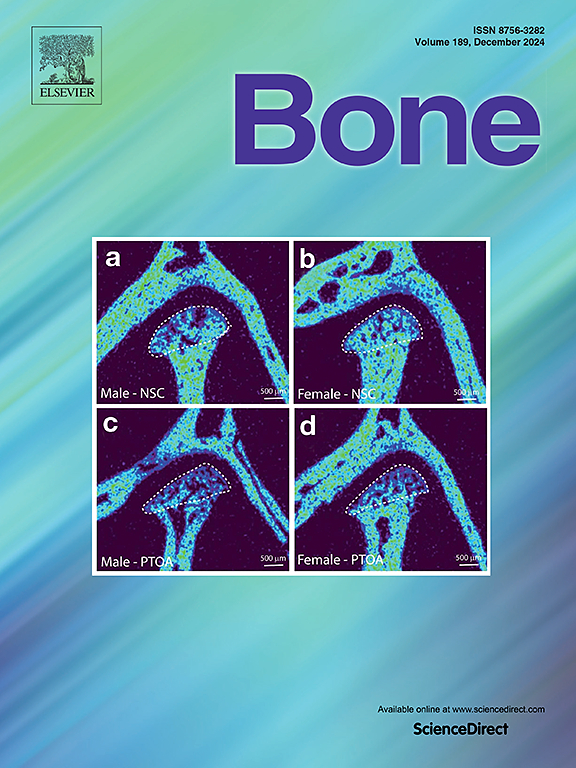探讨补体5a在心肌梗死后全身骨质流失中的作用。
IF 3.6
2区 医学
Q2 ENDOCRINOLOGY & METABOLISM
引用次数: 0
摘要
心肌梗死(MI)和骨质疏松性骨折是世界范围内发病率和死亡率的两个主要原因。我们之前已经确定,小鼠心肌梗死直接导致创伤后全身性骨质流失,交感神经系统在这种反应中起作用。然而,全身损伤反应是由多个系统介导的。在这项研究中,我们研究了补体5a (C5a)的作用,补体5a是创伤后多器官功能障碍的主要介质之一。对血清C5缺乏的12周龄雄性C57BL/6 J小鼠(B6/J)、C5a受体1敲除小鼠(C5aR1-/-)和B10·D2- hc0 H2d H2-T18c/oSnJ (B10·D2) (JAX株# 000461)进行手术诱导心肌梗死。使用显微计算机断层扫描和三点弯曲力学测试,分析心肌梗死后7、14和28天的全身和局部骨变化。采用抗酒石酸酸性磷酸酶(TRAP)染色法测定破骨细胞数量和活性,采用开阔视野法测定自愿活性水平。我们发现心肌梗死在L5椎体损伤后7 天诱导骨小梁峰值丢失,并在心肌梗死后28 天导致股骨皮质骨减少。然而,在此时间段内,心肌梗死未影响股骨小梁。与B6和B10·D2小鼠相比,B10·D2小鼠的骨小梁和骨皮质形态减少,但对心肌梗死的反应没有改变。心肌梗死后7天,C5aR1-/-小鼠的破骨细胞活性与B6和B10·D2小鼠相比有所增加,但心肌梗死在这个时间点不影响破骨细胞活性。总之,这些发现表明,C5a可能影响心肌梗死的整体反应和骨形态,而不是心肌梗死后创伤后全身性骨质流失反应,尽管可能不是主要机制。本文章由计算机程序翻译,如有差异,请以英文原文为准。

Investigating the role of complement 5a in systemic bone loss after myocardial infarction
Myocardial infarction (MI) and osteoporotic fracture are two of the leading causes of morbidity and mortality worldwide. We have previously established that MI in mice directly causes post-traumatic systemic bone loss and that the sympathetic nervous system plays a role in this response. However, the systemic injury response is mediated by multiple systems. In this study, we investigated the role of complement 5a (C5a), one of the main mediators driving multiple organ dysfunction after trauma. MI was surgically induced in 12-week-old male C57BL/6 J mice (B6/J), C5a receptor 1 knockout mice (C5aR1−/−) and B10·D2-Hc0 H2d H2-T18c/oSnJ (B10·D2), (JAX Strain # 000461) mice that are deficient in serum C5. Systemic and localized bone changes were analyzed at 7-, 14- and 28-days post-MI using micro-computed tomography and three-point bending mechanical testing. Osteoclast number and activity was quantified using tartrate-resistant acid phosphatase (TRAP) staining, and voluntary activity levels were measured using open field. We found that MI induced peak trabecular bone loss 7 days after injury in the L5 vertebral body and caused reductions in femoral cortical bone 28 days post-MI. However, MI did not impact femoral trabecular bone in this timeframe. B10·D2 mice had reduced trabecular and cortical bone morphology compared to B6 and C5aR1−/− mice, but did not exhibit an altered response to MI. Osteoclast activity 7-days post-MI was increased in C5aR1−/− mice compared to B6 and B10·D2 mice, but MI did not impact osteoclast activity at this time point. Altogether, these findings suggest that C5a may influence overall response to MI and bone morphology instead of post-traumatic systemic bone loss response following MI, though likely not as a primary mechanism.
求助全文
通过发布文献求助,成功后即可免费获取论文全文。
去求助
来源期刊

Bone
医学-内分泌学与代谢
CiteScore
8.90
自引率
4.90%
发文量
264
审稿时长
30 days
期刊介绍:
BONE is an interdisciplinary forum for the rapid publication of original articles and reviews on basic, translational, and clinical aspects of bone and mineral metabolism. The Journal also encourages submissions related to interactions of bone with other organ systems, including cartilage, endocrine, muscle, fat, neural, vascular, gastrointestinal, hematopoietic, and immune systems. Particular attention is placed on the application of experimental studies to clinical practice.
 求助内容:
求助内容: 应助结果提醒方式:
应助结果提醒方式:


